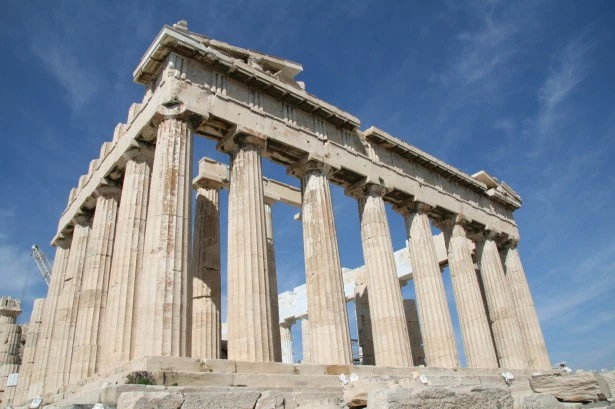If you are planning your visit, there are several things you should know about schedules, transportation, and prices.

This is hands-down the most frequently asked question by first-time visitors: “What exactly can I explore once I’m inside the Acropolis complex?“.
The answer is more extensive than most people realize – your single ticket unlocks access to both the iconic hilltop monuments and several additional archaeological treasures.
The Parthenon – The undisputed crown jewel of ancient Greek architecture, this magnificent temple dedicated to Athena stands as the ultimate symbol of classical civilization.
Temple of Athena Nike – A small but exquisitely crafted Ionic temple celebrating Athena as the goddess of victory.
Erechtheion – Famous for its elegant Caryatid Porch with six maiden columns, this sacred temple honors both Athena and Poseidon.
Propylaea – The monumental gateway serving as the grand entrance to the entire Acropolis sacred precinct.
Beyond the main hilltop monuments, your Acropolis ticket also includes:
North and South Slopes – These areas contain important archaeological remains and offer different perspectives of the main monuments you won’t get from the hilltop.
Theater of Dionysus – The birthplace of Greek drama, where masterpieces by Sophocles, Euripides, and Aeschylus premiered over 2,400 years ago.
Odeon of Herodes Atticus – A beautifully preserved Roman theater still hosting performances today.
These time-specific tickets eliminate the notorious queues and provide direct access to the entire Acropolis complex through dedicated entrances. The system operates on strict scheduling, so arriving at your designated time slot is crucial – but this timed approach ensures you’ll enjoy the site without overwhelming crowds.
Especially during peak season when morning slots sell out first.
EU citizens under 25 and non-EU visitors under 5 qualify for reduced admission, so bring valid ID for verification.
The 8:00 AM opening time is the best time to visit the Acropolis. You’ll enjoy temperatures that are 5-10°C cooler than midday and experience the site in its most serene state before the cruise ship influx arrives.
These cruise passengers typically flood the Acropolis between 9-10 AM, accounting for roughly 50% of daily visitors.
Tuesday and Thursday offer the smallest crowds, while weekends see maximum congestion. Avoid the 9-11 AM window entirely unless you’re there for opening – this period sees the heaviest bottlenecks from cruise arrivals.
Consider using the southeast lateral entrance, which is significantly less congested than the main western entrance. Most importantly, mandatory advance booking through the official platform is essential – morning time slots disappear quickly during high season, making early reservation your ticket to optimal timing.
Wear sturdy, non-slip shoes – the ancient marble surfaces can be surprisingly slippery, especially if there’s any moisture. Avoid heels or smooth-soled footwear at all costs.
Bring plenty of water and sun protection; there’s minimal shade on the hilltop, and Athens’ intense Mediterranean sun can be unforgiving.
The Acropolis is much larger than most visitors anticipate – this isn’t a compact museum where monuments are conveniently clustered together. The archaeological sites are spread across a considerable area, requiring significant walking between each major attraction.
While it’s technically possible to see the Acropolis in around 2 hours, this would result in a very superficial visit. Given the extensive walking distances and the wealth of monuments included in your ticket, allow 4-5 hours for a comprehensive visit that truly does justice to this UNESCO World Heritage site.
Visitors with disabilities over 67% receive free entry along with one companion upon presenting valid ID and Disability Certificate. Simply visit the ticket booths on your desired day – no advance booking required for entry, though elevator access should be reserved in advance through the official website.
A modern panoramic elevator was installed in December 2020, supporting up to 18 people or two wheelchairs with companions. The elevator provides stunning views during the ascent and delivers you to a flattened area for easy access at the top. Concrete paths and widened routes have been designed specifically for wheelchair access, though some areas still feature uneven ancient surfaces.
Accessible bathrooms are available both at the entrance and atop the hill. The route from ticket office to elevator is fully accessible, though it includes gentle inclines that may require assistance for manual wheelchair users. Adapted vehicles and specialized accessible tours are available for those needing additional support.
Acropolis metro station (red line) offers full elevator access, conveniently located near the site entrance. The Acropolis Museum is completely wheelchair accessible with ramps at both entrances, elevator access to all floors, and free wheelchair rentals available (though bringing your own is encouraged).
The Acropolis of Athens is Greece’s most popular tourist destination. The Parthenon, the Erechtheion, and the Propylaia are just a few of the…
The Acropolis has played a significant role in Greek history and culture and is widely regarded as one of the most important archaeological…
In the heart of Athens, Greece, on a rocky outcrop, stands the Acropolis, a well-known ancient landmark. The hill, standing at 156 meters high…
Taking the metro is a quick and convenient option for getting to the Acropolis in Athens. There are two metro stations that can be used to re…
While visiting the Acropolis in Athens is a must-see experience for anyone interested in ancient Greek history and culture, not visiting the…
Beat the crowds and scorching heat with Acropolis Skip the Line tickets. No more waiting in queues under the Greek sun….
